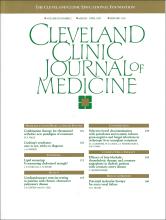ABSTRACT
Gram-negative and fungal infections are the most important cause of morbidity and mortality after liver transplantation, especially in the first postoperative month. From February 1989 to February 1990, all liver transplant recipients at The Cleveland Clinic Foundation, Cleveland, Ohio, were placed on a selective bowel decontamination regimen employing oral quinolones and nystatin beginning at the time they were put on the active waiting list for transplantation and continuing until the fourth postoperative week. The incidence of gram-negative and fungal infections for these patients was compared against a historical control group. Selective bowel decontamination was well tolerated and highly effective in reducing early serious gram-negative and fungal infections. This regimen may also reduce mortality.
- Liver Transplantation
- Decontamination
- Anti-Infective Agents
- Quinolone
- Nystatin
- Gram-Negative Bacteria
- Mycoses
- Copyright © 1993 The Cleveland Clinic Foundation. All Rights Reserved.






